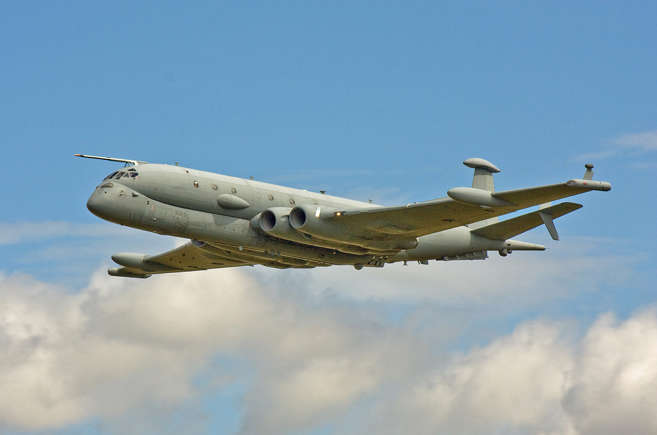1. The Vickers Windsor (Type 447)
✈ Role: High-speed heavy bomber
Developed during WWII as a successor to the Wellington, the Vickers Windsor featured a pressurized cabin, high aspect ratio wings, and a sleek design intended for long-range missions. But by 1945, with the war ending and jet technology rising, the Windsor was rendered obsolete and scrapped after a few prototypes.
2. Avro 730
✈ Role: Mach 3 high-altitude strategic bomber
The Avro 730 was Britain's answer to the U.S. B-70 Valkyrie—a hypersonic bomber capable of flying at Mach 3. With cutting-edge titanium construction and advanced avionics, it could have changed RAF capabilities. However, the 1957 Defence White Paper canceled it in favor of ballistic missiles.
3. Shorts Sperrin
✈ Role: Interim nuclear bomber
The Sperrin was a backup to the famous V-bombers in case delays hit the primary program. Though two were built, it was never deployed, as the Valiant, Vulcan, and Victor entered service smoothly. The Sperrin flew only as a testbed.
4. Handley Page HP.80 Victor B.3
✈ Role: Advanced nuclear bomber
While earlier Victor variants served in the RAF, the Victor B.3 was planned with updated engines and ECM (electronic countermeasures). Rising costs and shifting to missile-based deterrence led to its cancellation, even though it promised significant performance upgrades.
5. Hawker P.1005
✈ Role: Jet-powered light bomber
Designed near the end of WWII, the Hawker P.1005 was to be a fast bomber with a jet engine mounted in the fuselage. Intended to outrun enemy fighters, the project was shelved after the war in favor of more advanced designs and a shrinking need for light bombers.
6. English Electric Canberra PR.7 Jet Bomber Variants
✈ Role: Reconnaissance and tactical bombing
While the Canberra saw success globally, some high-speed and long-range variants like the PR.7 were canceled or limited in deployment due to the rapid development of more advanced jets and satellites for reconnaissance purposes.
7. Fairey FC1
✈ Role: Medium bomber / strategic design
Initially conceptualized pre-WWII as a futuristic bomber with a pressurized cabin and powerful engines, the Fairey FC1 was never built due to resource constraints and evolving war priorities.
8. Armstrong Whitworth AW.52G
✈ Role: Flying wing bomber
This experimental flying wing aircraft was a forerunner to stealth bombers like the B-2 Spirit. Though it showed promise in wind tunnel testing and concept development, the AW.52G was deemed too radical and shelved before full development.
9. BAC TSR-2
✈ Role: Tactical strike and reconnaissance bomber
Possibly the most controversial canceled aircraft in British aviation history, the BAC TSR-2 was a cutting-edge, low-level supersonic strike aircraft. It combined speed, terrain-following radar, and all-weather capability. Despite successful test flights, political and financial pressures killed it in 1965.
10. Miles M.52
✈ Role: Supersonic research bomber
Though not a bomber in the traditional sense, the Miles M.52 was meant to break the sound barrier and pave the way for fast bombing runs. Shockingly cancelled just before completion, its research indirectly benefited American supersonic flight programs like the Bell X-1.
✅ Nine Things You Need to Know About Cancelled British Bombers
1. They Represent the Shift in Warfare Doctrine
Most of these bombers were scrapped due to a shift from manned aircraft to ballistic missiles, especially during the Cold War. The 1957 Defence White Paper marked a turning point, cutting numerous aviation programs in favor of nuclear deterrence via missiles.
2. Jet Technology Rendered Older Designs Obsolete
As jet engines evolved rapidly in the 1950s and 1960s, several bombers under development were simply too slow or outdated before they even flew. Speed, range, and survivability became the new priorities.
3. Political Decisions Trumped Engineering
Many of these aircraft—especially the TSR-2—were canceled not due to technical failure, but due to budget cuts, political opposition, and defense policy changes. These decisions often sparked debate in Parliament and among military historians.
4. Test Prototypes Were Still Valuable
Even when bombers were canceled, prototypes often contributed to research in aerodynamics, propulsion, or avionics. For instance, the Sperrin was later used to test jet engines and weapon systems.
5. UK Aerospace Innovation Was World-Leading
Despite the cancellations, British engineers pushed the limits of aircraft design. Supersonic speeds, flying wing concepts, and terrain-following radar were all cutting-edge. Some designs even inspired future aircraft in the U.S. and Europe.
6. Collaboration with Allies Played a Role
In some cases, British bomber development was halted due to anticipated NATO collaboration or procurement from U.S. suppliers. The cancellation of TSR-2, for example, partly led to the adoption of the American F-111 (though that deal later collapsed too).
7. Resource Constraints Were Constant
Post-WWII Britain faced financial challenges, and large-scale aircraft projects were extremely costly. Often, the government prioritized economic recovery over experimental military programs.
8. Some Ideas Were Too Advanced for Their Time
Bombers like the Avro 730 or Miles M.52 were technological marvels, but the materials, computing power, or manufacturing techniques simply weren’t ready. These programs were visionary—but too far ahead of their era.
9. Their Legacy Still Lives On
Though these bombers never saw combat, their influence endures. Concepts from these aircraft helped shape the Concorde, Eurofighter Typhoon, and modern stealth designs. Museums and documentaries now preserve their stories as part of Britain's proud aviation heritage.
Conclusion: The Forgotten Bombers That Shaped the Future
These 10 cancelled British bombers may never have dropped a payload, but they left a significant mark on aviation history. They represent bold thinking, cutting-edge engineering, and the complexities of balancing military needs with economic and political realities.
For aviation enthusiasts, defense analysts, or anyone curious about “what might have been,” these aircraft offer a fascinating glimpse into a time when the future of war was being drawn on drafting tables across the UK.


You must be logged in to post a comment.